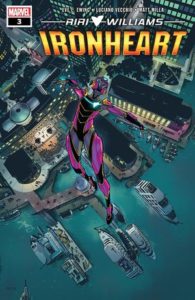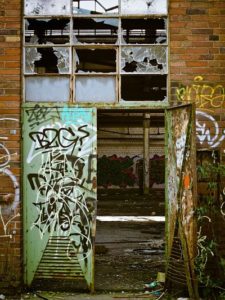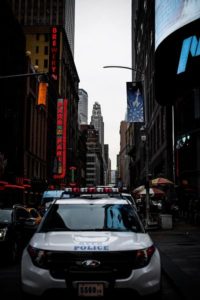
image: book cover: collage-style face of African American girl in blue with green leaves and multi -color disk.
(Photo of Eve Ewing by Lauren Miller: smiling African American woman at mike wearing yellow shirt with slogan: We All We Got.)
The purpose of this blog is to recommend books that may have escaped your notice. If you go to Eve L. Ewing’s website you’ll see that she has received many awards, and considerable media attention. Trevor Noah, Ta Nehisi Coates, Alicia Garza – all have interviewed her to discuss her second book, The Ghosts in the Schoolyard: Racism and School Closings on the Southside of Chicago. Still, even books that get a brief flurry of publicity can disappear from view, and I’d like poetry-lovers to find this one.
Ghosts in the Schoolyard led me to Electric Arches and to the author’s website. Ewing contains multitudes; she is a sociologist at the University of Chicago, community activist, visual artist, poet, and writer of Marvel’s Ironheart comics. Her website is a rabbit hole filled with wonders, where you’ll fall farther than Alice ever did, and discover posters, silkscreens, charcoal drawings, photographs, installations. https://eveewing.com/

image: comic book cover: Black woman superhero soars above city
Sometimes when I review a book of poetry I just want to transcribe the whole thing and have you read it. But this still wouldn’t give you all of Eve Ewing’s book, because it would leave out the varied typography, collage, mixed media. All I can do is write about some of the pieces that particularly spoke to me, and give you tempting tastes.
She introduces the book: When I was a little girl, I was allowed to ride my bicycle from one end of the block to the other, because that way my mother could come outside and stand on the sidewalk and see me…[A]s I rode my bike I would narrate, in my head, all my adventures. In my head I was shooting arrows, exploring dungeons, solving mysteries. In this way, my block became the backdrop of infinite possibilities, even if the reality of the cracked cement and the brick wall facing our window and the gangs seemed to constrain that possibility….

image: brick wall with graffiti and broken windows. from pixabay at pexels
Ewing’s jubilant imagination still creates light from dark matter. Hers is intimate poetry that presents a whole world, celebrates a rich life in a poor place, a beloved city-home of broken concrete and bricked- up windows. She goes straight to the heart of the matter, and her poetry to the heart of the reader.
As a child she would go to Chicago’s Navy Pier with her father, where he had a booth to draw portraits.
Back then there was the ferris wheel
and the 21st century McDonald’s
with the glass orb you can touch and pink lightning
comes to your fingerprints like a fruit punch stain
and not much else. You’d barely recognize it.
Navy Pier was a new and desperate thing,
and instead of fireworks a man set himself on fire
and jumped in the water every night at ten, I’m not even kidding…
While her father worked, she sold
…glow sticks to pass the time,
Making chains of them and hanging them on my skinny arms by the dozen,
Yelling at tourists the slogans I invented – light up the night with a glow light!…” t Work with My Father

image: cloudy sky, tall skyscrapers behind riverfront amusement park, ferris wheel and boats. pixabay at pexels.com
She writes about the demolition of a community hospital:
The first stone is the hardest
which is why they don’t use hands anymore
Too much, the push of the granite on the pads of the fingers….
Wrecking balls don’t get arthritis or cry
or show up on the site with lunches that their wives made,
bleary-eyed, standing in worn housecoats in the darkness.
The dynamite never says, ‘But my uncle died here, in this hospital…
while the tremor spreads
and the walls come down.”
Columbus Hospital

image: man stands looking at site of demolished building derelict buildings in background. free creative stuff at pexels.com
A prose poem includes Moses, Abraham and Eve, the tribulations of Black people, “a people forever in exodus,” her simultaneous faith in superstitions and the science of the universe, and finally the main subject, her grandmother, president of the choir at Shiloh Baptist Church.
Even when I was tiny I could hear that she was singing even when she was not singing – no woman could offer you a piece of toast or a glass of gingerale in such a lilting, untouchable soprano, or tell you that Grandpa was going to hit you with a comb if you didn’t settle down and have it sound so like a Wagnerian opera.
[Grandma] is wearing a grandma uniform…she has just returned from singing at church and so her hair and make-up are impeccable, and has also changed into a pearl-colored cotton housecoat with faint traces of a floral pattern, and a pair of slippers….This particular housecoat thrives on against all odds, and rather than clashing with the hair and makeup…they exist in a sort of détente. They have tolerated each other for this many years and they might as well keep on keeping on.”
What I Talk About When I Talk About Black Jesus
Reading her poetry with three other Black poets in a small town museum, she is cold and lonely.
The work of the poet is not unlike the work of being Black
Some days it is no work at all: only ease, cascading victory,
the plentitude of joy and questions and delights and curiosities.
Other days you wonder if exile would be too lonely,
and figure it can’t be worse than thinking you won’t make it home…”
Sestina with Matthew Henson’s Fur Suit
Inspired by a quotation from Assata Shakur,** Black revolutionaries do not drop from the moon. We are created by our conditions, she imagines moon people descending and changing the world.
…and they sang while
they smashed a bottle on the squad cars…to say ‘this
here is christened a new thing.’ And they drove them down my street
and your street and your street, the tires painted to look like vinyl 45s
and the children tied yarn and ribbons to the windshield wipers
and the moon people turned them on high so that as they drove, the colors
waved in the sunlight…
Arrival Day

image: police car foreground, street scene with skyscrapers behind. jiarong deng at pexels.com
In Sonia Nadia McDonald’s article in the online magazine The Undefeated, “How to Get More Black on Broadway,” she quotes David Mendizabal of The Movement Theatre Company: “What are stories that we’re not seeing? I mean the first thing that came to my mind was joy. Black joy, brown joy.” https://theundefeated.com/ Eve L. Ewing’s poetry brings us times of trouble and times of joy; she brings us a whole world, evoking understanding, recognition and laughter.
**Assata Shakur – writer, member of the Black Liberation Army, escaped from prison, now a fugitive in Cuba


Liz…………..Where, How, do you find this wonderful stuff?
In my bookcase with all the other books I buy on spendthrift days and plan to read someday. At the Decatur Book Fair I bought her book about closing black schools in Chicago, and saw she was a poet, and ordered this book.
Lovely essay.
Thank you Julie!